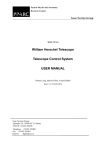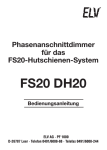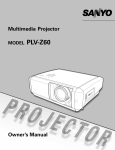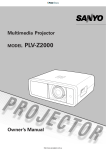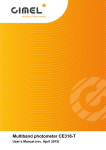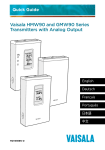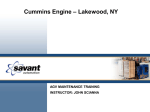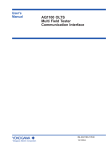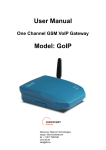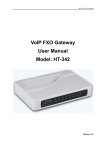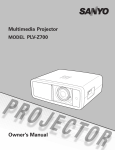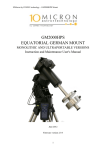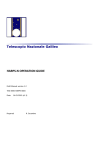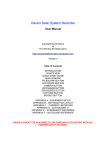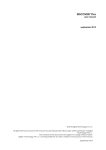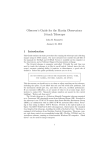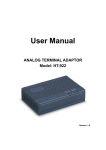Download INT - Isaac Newton Group of Telescopes
Transcript
Particle Physics and Astronomy Research Council Isaac Newton Group INT-TCS-1 Isaac Newton Telescope Telescope Control System USER MANUAL Marion Fisher Issue 3.1; 7 September 2007 Isaac Newton Group, Apartado 321, 38780 S/C La Palma, Tenerife , Canary Islands Telephone +34 922 425400 Fax +34 922 425401 Internet [email protected] INT-TCS-1 issue 3.1 INT TCS User Manual Table of Contents 1. INTRODUCTION 6 1.1 Purpose 6 1.2 Scope 6 1.3 Definitions 6 1.4 Overview 6 2. STARTING AND STOPPING THE TCS 7 2.1 Startup 7 2.2 Stopping the TCS 8 3. TCS USER INTERFACE COMMANDS: SUMMARY 9 3.1 General TCS commands 9 3.2 Source data entry 9 3.3 Catalogue handling 9 3.4 Source change 9 3.5 Positional and Aperture offsets 10 3.6 Autoguiding 10 3.7 Calibration procedures 10 3.8 Mechanism control 10 3.9 Mechanism configuration 10 3.10 Change of focal station and instrument 11 3.11 Display functions 11 3.12 Logging of test data 11 3.13 Meteorological and Earth-rotation data 11 TCS USER INTERFACE COMMAND LIST 12 4. 4.1 ACKNOWLEDGE 12 4.2 ADD 12 4.3 AGLIMIT 13 –2– INT-TCS-1 issue 3.1 INT TCS User Manual 4.4 AGSELECT 13 4.5 AGVIEW 13 4.6 APERTURE 13 4.7 AUTOGUIDE 14 4.8 BEAMSWITCH 14 4.9 BLIND_OFFSET 15 4.10 CALIBRATE 15 4.11 CLONE 16 4.12 DEC 16 4.13 DFOCUS 17 4.14 DIFF_RATES 17 4.15 DISPLAY 17 4.16 DOME 18 4.17 ENCODER 18 4.18 ENGINEERING 19 4.19 ENTER 19 4.20 EPOCH 19 4.21 EQUINOX 20 4.22 ERASE 20 4.23 FIND 20 4.24 FOCUS 20 4.25 GOCAT 21 4.26 GOMOON 21 4.27 GOTO 21 4.28 HANDSET 22 4.29 HELP 22 4.30 HUMIDITY 22 4.31 INCLUDE 23 4.32 INSTRUMENT 23 –3– INT-TCS-1 issue 3.1 INT TCS User Manual 4.33 LIMITOFFSET 23 4.34 LOG 24 4.35 MARK 24 4.36 MOON 24 4.37 NEXT 25 4.38 OFFSET 25 4.39 OUTPUT 25 4.40 PAGE 26 4.41 PARALLAX 26 4.42 PARK 26 4.43 PM 26 4.44 POINT 27 4.45 POLE 27 4.46 POSITION 27 4.47 PRESSURE 28 4.48 PROBE 28 4.49 PROPER_MOTION 28 4.50 RA 28 4.51 RADIAL_VEL 29 4.52 RECALL 29 4.53 REMOVE 29 4.54 RMS 30 4.55 ROTATOR 30 4.56 RV 30 4.57 SHOW 31 4.58 SLOWOFF 32 4.59 SNAPSHOT 32 4.60 SOURCE 32 4.61 STATION 33 –4– INT-TCS-1 issue 3.1 INT TCS User Manual 4.62 STOP 33 4.63 STORE 34 4.64 TCSEXIT 34 4.65 TEMPERATURE 34 4.66 TRACK 35 4.67 TRANSFER 35 4.68 TWEAK 35 4.69 UT1UTC 35 4.70 WAVELENGTH 36 4.71 ZEROSET 36 5. THE TCS HANDSET 38 5.1 General 38 5.2 Handset modes 39 5.3 Sign conventions 40 6. THE TCS DISPLAY 41 6.1 General 41 6.2 Source and telescope information 41 6.3 Encoder display 43 6.4 Limit page 45 6.5 Dome status and manual overrides page 46 7. CATALOGUES 48 7.1 Catalogue format 48 7.2 The System Catalogue 48 –5– INT-TCS-1 issue 3.1 INT TCS User Manual 1. INTRODUCTION 1.1 Purpose This document is the User Manual for the Telescope Control Software (TCS) at the Isaac Newton Telescope (INT). 1.2 Scope This document applies only to the TCS User Interface, use of the TCS via the DRAMA interface is not covered. 1.3 Definitions α Right ascension δ Declination ψ parallactic angle θ sky position angle ρ mount position angle ξ, η Cartesian coordinates in the tangent plane, parallel to +α and +δ respectively x, y Cartesian coordinates in the tangent plane along mount position angle 0° and 90° respectively, in the input coordinate system xA, yA Cartesian coordinate system fixed in the focal plane 1.4 Overview The TCS runs on an Alphastation under the VMS operating system. Some commands are not available via the DRAMA interface, this is noted in the command descriptions and in the command summary. –6– INT-TCS-1 issue 3.1 INT TCS User Manual 2. STARTING AND STOPPING THE TCS 2.1 Startup To start the TCS, log in to LPAS2 either from the X terminal in the INT control desk, or from a terminal window on the Instrument Control computer. The username and password are displayed on the X terminal. If the TCS is not running, you will be presented with a START menu similar to: This is the INT TELESCOPE CONTROL SYSTEM The TCS is not running. Please enter an option START - Start the TCS version I20-1-0 Info display on lpx22.ing.iac.es USER window on lpx22.ing.iac.es SIMULATE - Run the TCS version I20-1-0 in simulation mode Info display on lpas2 USER window on lpas2 VERSION - Select a different TCS version DISPLAY - Select different display devices EXIT - Exit this menu and log out Option> START runs the displayed TCS version. The login window disappears, then the Display and User windows appear. The User window displays a few lines of information followed by the USER> prompt. VERSION allows the user to choose a different version of the TCS. A list of the available versions is displayed: enter the version required, or press RETURN to keep the default value. DISPLAY is used to select a different device for the Display and User windows. Enter the IP name or address of the new device for the Display window, and again for the User window. Pressing RETURN will keep the default value. It is possible for the Display and User windows to be on different devices. If the TCS is already running, the following menu will be displayed: This is the INT TELESCOPE CONTROL SYSTEM The TCS is running, using version I23-0-0 Please enter an option STOP TELD - Stop the TCS - NFSMOUNT EXIT Start the TELD task Mount the ICS Unix partition - Exit this menu and log out Option> –7– INT-TCS-1 issue 3.1 INT TCS User Manual STOP will stop the running TCS, then after waiting for 20 seconds for the sub-processes to die the START menu will be displayed. TELD will start TELD, the task which communicates between the TCS and the ICS via DRAMA. If TELD is already running, it will be stopped and restarted. NFSMOUNT will dismount all NFS mounts and remount the ICS Unix partition which is used by the TCS to write the FITS header, and also to access user catalogues. TELD and NFSMOUNT are not present on the START menu, as both actions are part of the TCS startup procedure. 2.2 Stopping the TCS Always zenith park the telescope and switch to engineering mode first. Under normal circumstances, the TCS should be closed down using the TCSEXIT command at the user interface (see command list). If the user interface is not working (e.g. its window has disappeared or has been accidentally deleted), then the system can be stopped from another login session. Log in as described in the previous sub-section and type STOP at the Option> prompt. –8– INT-TCS-1 issue 3.1 INT TCS User Manual 3. TCS USER INTERFACE COMMANDS: SUMMARY This section contains a summary of the commands available at the user interface of the telescope control system, classified into functional groups. Details of individual commands are given in the alphabetical list in the next section. Commands which require the telescope or one of its mechanisms to be moved are forbidden in engineering mode. 3.1 General TCS commands All allowed in engineering mode. HANDSET, HELP, RECALL and TRANSFER are not allowed from DRAMA. • ACKNOWLEDGE • CLONE • HANDSET • HELP • RECALL • TCSEXIT • TRANSFER Turn off a limit or engineering mode alarm. Make a copy of the display window on another device. Select handset mode. Get help on a command. Recall a previous command. Close down the control system. Transfer control to or from a remote terminal. 3.2 Source data entry All allowed in engineering mode. • DEC Enter declination of edit source. • DIFF_RATES Enter non-sidereal tracking rates for the edit source. • EPOCH Enter epoch of position for edit source. • EQUINOX Enter equinox for edit source. • PARALLAX Enter parallax of edit source. • PM Synonym for PROPER_MOTION (q.v.). • PROPER_MOTION Enter proper motions of edit source. • RA Enter right ascension of edit source. • RADIAL_VEL Enter radial velocity of edit source. • RV Synonym for RADIAL_VEL (q.v.). • SOURCE Enter name, right ascension, declination and equinox for edit source. 3.3 Catalogue handling All allowed in engineering mode. • ADD • ERASE • FIND • INCLUDE • MARK • OUTPUT • REMOVE Add the contents of the edit source block to the catalogue as a named entry. Clear the user catalogue. Get a named catalogue entry and put it in the edit source block. Append a text catalogue to the current user catalogue. Store the current telescope position as a named catalogue entry. Output the current catalogue to an ASCII file, terminal or line printer. Delete a catalogue entry. 3.4 Source change None allowed in engineering mode. –9– INT-TCS-1 issue 3.1 • BLIND_OFFSET • GOCAT • GOMOON • GOTO • NEXT INT TCS User Manual New source (from catalogue) with local corrections to the pointing model. New source (from catalogue; specified by name only). New source (moon coords from sla_DMOON) New source (direct input of name, right ascension, declination and equinox). New source (using data in edit source block). 3.5 Positional and Aperture offsets ENTER is allowed in engineering mode; the remainder are not. • APERTURE • ENTER Execute a preset (numbered) aperture offset. Execute an aperture offset with direct input of x and y. Input data for numbered aperture or positional offsets. • OFFSET Execute a positional offset with direct input of Δα, Δδ or ξ,η. • POSITION • STORE Execute a preset (numbered) positional (ξ,η) or Δα, Δδ) offset. Execute a positional offset at a given rate with direct input of ξ,η and rate. Store aperture or positional offsets set up using the handset. • TWEAK Apply a given (xA, yA, ρA) aperture offset. • BEAMSWITCH • SLOWOFF 3.6 Autoguiding AGSELECT and PROBE are allowed in engineering mode; AGVIEW and AUTOGUIDE are not. • AGLIMIT • AGSELECT • AGVIEW • AUTOGUIDE • PROBE Set the limit determining whether the guidestar is in position. Identify the autoguider currently in use. Aperture offset to move image to autoguider field. Lock or unlock the autoguider loop. Input coordinates of guide probe. 3.7 Calibration procedures The keywords for this command which require the telescope to be moved are not allowed in engineering mode. • CALIBRATE Determine encoder zero-points and collimation errors. 3.8 Mechanism control None allowed in engineering mode. • DOME • DFOCUS • FOCUS • PARK • ROTATOR • STOP Move the dome to a given azimuth and stop it. Change the focus by a specified amount. Move the focus to a specified position. Move the telescope to a defined position. Move the rotator to a given sky PA. Stop a mechanism or combination of mechanisms. 3.9 Mechanism configuration ENCODER, LIMITOFFSETand ZEROSET are allowed in engineering mode; TRACK is not. • ENCODER • ENGINEERING Set the combination of encoders used for pointing. Select engineering mode. – 10 – INT-TCS-1 issue 3.1 • LIMITOFFSET • TRACK • ZEROSET INT TCS User Manual Change the limits of the Cass rotator forbidden zone. Turn focus, dome, rotator or telescope tracking on or off. Determine incremental encoder zero-points. 3.10 Change of focal station and instrument Note that “Select” in this context means “set up software and drive the correct rotator”. Both allowed in engineering mode. • STATION • INSTRUMENT Select focal station. Tell the TCS which instrument is in use. 3.11 Display functions All allowed in engineering mode. MOON and SHOW are not allowed from DRAMA. • DISPLAY • MOON • PAGE • SHOW Change the coordinate system of the displayed telescope position. Give the current right ascension and declination of the Moon. Switch to another information display page. Display information about the system state. 3.12 Logging of test data All allowed in engineering mode. • LOG • POINT • RMS • SNAPSHOT Log encoders, tracking errors and associated data. Write encoder coordinates to a data file. Calculate and display mean and rms servo errors. Record the current information display page. 3.13 Meteorological and Earth-rotation data All allowed in engineering mode. • HUMIDITY • POLE • PRESSURE • TEMPERATURE • UT1UTC • WAVELENGTH Input relative humidity used in refraction calculation. Input values of polar motion. Input barometric pressure used in refraction calculation. Input temperature used in refraction calculation. Input UT1 – UTC. Input wavelength used in refraction calculation. – 11 – INT-TCS-1 issue 3.1 INT TCS User Manual 4. TCS USER INTERFACE COMMAND LIST The following section gives a brief description of the operation of each command together with examples and defaults. It refers to the TCS local interface. Notation: • Examples of commands entered at the terminal are in typewriter font: DEC 12 34 56.78; • Angle brackets denote parameter values or keywords: <angle>; • Square brackets denote optional parameter values or keywords: [x,y]; all other parameters and keywords are obligatory. In most cases, TCS commands can be issued either at the local user interface terminal or using the DRAMA interface. The command syntax when using DRAMA is identical to the local interface, but the complete command must be issued. Prompts for unspecified input are issued on the local interface, not on the DRAMA interface, and if the prompted-for input is not given on the local interface, the DRAMA command will hang until it times out. The main differences between the local interface and the DRAMA interface are: • DRAMA will always acknowledge completion of a command. Response will be almost • • • • instantaneous except for commands which move the telescope mechanisms. These complete when the mechanisms concerned are in position. There is no prompting on the DRAMA interface. Error messages differ, usually in the sense that the TCS gives an additional, more accurate description of the problem. DRAMA does not allow a command to be issued if a previous attempt at the same action is still in progress. The TCS local interface allows the first command to be overridden by the second. This can sometimes lead to problems (e.g. if the wrong object is selected). A few commands (primarily those which produce screen output) are not available from DRAMA. These are noted explicitly below. 4.1 ACKNOWLEDGE Turn off the engineering mode and/or software limit alarms. Format: ACKNOWLEDGE <alarm_type> Defaults: ACKNOWLEDGE ALL Parameters: None. Keywords: LIMIT turn off an alarm caused by a main drive software limit; ENGINEERING turn off an alarm caused by an unexpected switch into engineering mode; ALL turn off any alarm. ACKNOWLEDGE Example: Comments: An alarm (continuous bleeping) is triggered if the telescope or rotator encounters a software limit whilst tracking or when requested to slew to an object below the horizon or if a switch from computer to engineering mode occurs unexpectedly (i.e. not as a result of an ENGINEERING or TCSEXIT command). 4.2 ADD Write the current contents of the edit source block as a new entry in the user catalogue. Format: ADD – 12 – INT-TCS-1 issue 3.1 INT TCS User Manual Defaults: None. Parameters: None. Keywords: None. 4.3 AGLIMIT Set the limit that determines whether the guidestar is in position. Format: Defaults: Parameters: Limits: Examples: Comments: AGLIMIT <limit> None. The limit in arcseconds. 0 to 5 arcseconds. AGLIMIT 2.5 This command is useful in conditions of bad seeing, when the default limit of 0.5 arcseconds is too small. 4.4 AGSELECT Select which autoguider to use. Format: Defaults: Parameters: Keywords: Examples: Comments: AGSELECT <autoguider_name> None. The prime-focus autoguider is selected on startup. None. Valid autoguider names are: CASSEGRAIN the Cassegrain off-axis autoguider; PRIME the prime-focus (Wide-Field Camera) autoguider. AGSELECT CASS The TCS needs to know which autoguider is currently in use in order to perform the conversion between guide star pixel position and drive corrections. 4.5 AGVIEW Perform an aperture offset to move an image onto the autoguider CCD. Format: Defaults: Parameters: Keywords: Comments: AGVIEW None. None. None. This command allows a field to be viewed using the autoguider. An offset is applied to move the image from the nominal aperture (usually the rotator centre) to the centre of the autoguider field. It is essential to tell the TCS which autoguider is in use and to define its position in the focal plane (use the AGSELECT and PROBE commands as necessary). 4.6 APERTURE Offset the telescope so that an object moves by a vector fixed in the focal plane. Format: Defaults: APERTURE <aperture_number> None. The reference position (aperture 0) is selected on startup. This is usually also the rotator centre, (0,0). Parameters: The aperture number is in the range 0 to 20. The corresponding (xA , yA ) displacement must have been set up previously by using the ENTER or STORE commands. APERTURE 0 is the reference position (see below). – 13 – INT-TCS-1 issue 3.1 Keywords: Examples: Comments: INT TCS User Manual None. APERTURE 2 An (xA , yA ) shift in the focal plane is divided into two parts: the reference position, which is unaltered on source change, and an aperture offset which is reset to zero on source change. The APERTURE command provides a means of switching between the reference position and previously-defined aperture offsets. 4.7 AUTOGUIDE Lock or unlock the CCD autoguider loop. Format: AUTOGUIDE <state> [<x> <y> [WAIT]] Defaults: None. Parameters: The optional parameters x and y are the desired pixel coordinates for the guide star and are used with the ON keyword. If they are not specified, the system will adopt the most recent autoguider coordinates sent to the TCS. WAIT is designed for use when the AUTOGUIDE command is sent via DRAMA. The command will not complete until the guidestar is in position. The ‘in-position’ limit can be changed with the AGLIMIT command. Keywords: Valid autoguider states are: ON specifying that the telescope should be guided in response to guiding errors from the CCD autoguider. OFF specifying that autoguiding should be switched off, i.e. that any guiding errors from the CCD autoguider should be ignored. SUSPEND put the TCS in a state where pixel coordinates are read from the autoguider and the current reference position is maintained, but guiding errors are not applied. RESUME Restart guiding if the loop has been suspended. AUTOGUIDE ON Examples: AUTOGUIDE ON 122.5 63.5 Comments: The autoguider sends xy pixel coordinates of a guide star to the telescope control computer. The TCS then adjusts the telescope drives to keep the star at a given location on the autoguider CCD. If the intention is to maintain the current positioning of a field (e.g. if acquisition onto a spectrograph slit has been verified), then the command AUTOGUIDE ON should be used. This takes the most recent position received from the autoguider when the command was issued, and keeps the guide star there. On the other hand, if the autoguider coordinates are already known, then the appropriate command is AUTOGUIDE ON x y. This is likely to be useful when an observation is to be repeated and the field is to be positioned at the same place on the detector. The guide probe and pixel positions should be repeated. The TCS must know the autoguider in use (see AGSELECT), otherwise the telescope corrections will be in the wrong direction. The function key F8 is equivalent to the AUTOGUIDE OFF command. The function key F9 is equivalent to the AUTOGUIDE ON command. If the autoguider is not sending packets, or if the data is unreliable due to low signal, then the AUTOGUIDE command is ignored. 4.8 BEAMSWITCH Offset the telescope so that an image moves by a vector fixed in the focal plane. Format: Defaults: BEAMSWITCH <offset_x> <offset_y> None. On source change (e.g. GOTO), offsets are reset to the nominal values (this can also be done with the BEAMSWITCH 0 0 or APERTURE 0 commands: see APERTURE). Parameters: The aperture (xA, yA ) positions in arcseconds. – 14 – INT-TCS-1 issue 3.1 Keywords: Examples: INT TCS User Manual None. BEAMSWITCH 20.2 -100 4.9 BLIND_OFFSET Offset between a reference object centred on the reference position and a faint target object. Format: Defaults: Parameters: Keywords: Examples: Comments: BLIND_OFFSET <source_name> None. The name of the faint target object. None. BLIND 0512+22E This is the standard method for locating very faint objects, which are difficult or impossible to see on the acquisition TV or detector. Accurate positions for a brightish star and the faint target object must be entered in the catalogue. Slew to the bright star using GOCAT and centre it on the reference position with the handset keys. Then type BLIND <source_name> for the faint object. This offsets the telescope so that the faint object is accurately aligned with the reference position. It can then be moved around the detector using the BEAMSWITCH or APERTURE commands. BLIND_OFFSET performs a local correction to the pointing model, assuming that the position of the reference object is accurate. Subsequent executions of BLIND_OFFSET all use this correction, so several faint objects can be observed using the same reference star. The NEXT, GOTO and GOCAT commands revert to the default global pointing solution. 4.10 CALIBRATE Update pointing coefficients at the start of an observing session. Format: Defaults: Parameters: Keywords: CALIBRATE <solution> CALIBRATE NEW None. Valid keywords are: LAST recalls the last pointing solution. This may be useful if the running of the control program has been interrupted, but does not ensure very accurate pointing because the encoder zero-points may have changed. DEFAULT reverts to the default pointing solution in the initialisation file. This is a suitable course of action if the CALIBRATE command fails e.g. gives very large rms errors). NEW packages a sequence of commands to do a short pointing calibration using bright (FK5) stars. FAINT does the same as NEW but with a grid of fainter ( V ≈ 9 ) stars. ZEROPOINT logs the current encoder reading and analyses it with a modified TPOINT procedure to calculate and install the 2 encoder zeropoints IH and ID. This is the equivalent of the SNAFU command on the Perkin-Elmer TCS. COLLIMATION logs the current encoder reading and analyses it with a modified TPOINT procedure to calculate and install the 2 collimation coefficients CH and ID. ANALYSE analyses the pointing log file generated by a series of POINT commands, then calculates and installs the coefficients IH, ID and CH. It is designed to be used when the procedure is run by the system computer rather than the TCS, and allows other TCS – 15 – INT-TCS-1 issue 3.1 INT TCS User Manual commands to be input during the procedure. This means that the autoguider can be used to centre the star, as AUTOGUIDE commands will be accepted. The ANALYSE keyword can take an optional keyword ZERO or COLL. In this case, the log file generated by a single POINT CALIBRATE command is analysed, then the coefficients, IH,ID or CH,ID respectively, are calculated and installed. Examples: Comments: CALIBRATE CALIBRATE LAST The CALIBRATE NEW command initiates an automatic sequence which does a restricted pointing measurement on 7 stars from the pointing grid in order to update the values for the encoder zero-points in hour angle and declination and the collimation error in hour angle. Stars are selected to be close to the meridian and covering the full range of declinations. The telescope is driven to the first star and the handset mode is selected. When the telescope is tracking, the star should be moved on to the reference position using the handset keys. Once you are satisfied, press F6. This logs the position and drives to the next star. If you do not wish to log the star, then press I while still in handset mode: the star will be skipped and the telescope will drive to the next star. Repeat these operations until all 7 positions have been logged. You will then be asked whether all of the stars were centred correctly. If you do not answer Y to this question, then the procedure will be aborted. The derived and previous values will be displayed, together with their r.m.s. errors, and you will be asked whether the solution is reasonable. The errors should be in the range 0.5 to 1.0 arcsec for ID, 1.0 to 2.0 arcsec for CH and 1.0 to 3.0 arcsec for IH. If the errors are much larger than these values, then the solution should be rejected. Unless there has been a major change of configuration, the coefficients should not alter by more than a few arcseconds from night to night. Gross differences may indicate a problem. CTRL–Z may be used to abort the procedure at any time, but all of the measurements will be lost. 4.11 CLONE Create/delete a copy of the DISPLAY screen. Format: Defaults: Parameters: Keywords: Examples: Comments: CLONE <state> <device> None. The name or IP address of the display device. The allowed states are: ON creates a copy of the display screen on the specified device. OFF deletes all copies of the display screen from the specified device. CLONE ON lpx31 CLONE OFF 161.72.6.108 If a window created by CLONE is closed other than by the CLONE OFF command, e.g. by using the window buttons, the command CLONE OFF device must be issued to clear internal variables. 4.12 DEC Enter a declination in the edit source block. Format: Defaults: DEC <dec_degrees> <dec_minutes> <dec_seconds> Value of declination: None Sign of declination: ‘+’. – 16 – INT-TCS-1 issue 3.1 INT TCS User Manual Parameters: The declination in degrees, minutes and seconds of arc. The value is rejected if any of the components lie outside the following ranges: dec_degrees 0 to 89 inclusive dec_minutes 0 to 59 inclusive dec_seconds 0.0 to 59.99… inclusive Keywords: None. DEC -12 34 56.78 Examples: 4.13 DFOCUS Offset the focus to compensate for additional optical elements. Format: Defaults: Parameters: Keywords: Limits: Examples: Comments: DFOCUS <focus_offset> None. Focus offset, in mm. None. –10 to 10 mm. DFOCUS 0.3 This command is intended to be used when the telescope focus has to be changed to compensate for the additional optical thickness of a filter. The virtual focus reading is unchanged, and the focus offset in use is displayed in the DF field on the bottom line of the Information Display. 4.14 DIFF_RATES Enter differential tracking rate in right ascension and declination. Format: DIFF_RATES <diff_rate_in_ra> <diff_rate_in_dec> Defaults: None. Unspecified differential rates are assumed to be zero. Parameters: Right ascension and declination differential tracking rates in seconds/second and arcseconds/second, respectively. Keywords: None. Limits: –100 to 100 s/s in RA and –100 to 100 arcsec/s in declination. DIFF_RATES 0.01 -0.3 Examples: Comments: The differential (non-sidereal) tracking rates are added to the edit source block. They must be actioned using the NEXT command. Note that differential rates are not included in a catalogue entry. 4.15 DISPLAY Change the coordinate system of the information display. Format: Defaults: Parameters: Keywords: DISPLAY <coordinate_system> None. The default coordinate system on startup is INPUT. None. The allowed coordinate systems are: INPUT α and δ in the system used to input the source position; APPARENT α and δ in geocentric apparent coordinates; J2000 α and δ in J2000 mean coordinates; B1950 α and δ in B1950 mean coordinates; HA_DEC Topocentric hour angle and declination. – 17 – INT-TCS-1 issue 3.1 Examples: Comments: INT TCS User Manual DISPLAY J2000 For technical reasons, there are restrictions on the permitted combinations of input and display coordinates, as follows: INPUT always allowed; APPARENT always allowed; J2000 not allowed for input in apparent coordinates; B1950 not allowed for input in apparent or FK5 (J) coordinates; HA_DEC always allowed. 4.16 DOME Move the dome to the specified azimuth and stop. Format: Defaults: Parameters: Limits: Keywords: Examples: DOME <angle> None. The angle in degrees. The angle must be in the range 0 to 360°, even though the dome has no mechanical limits. None. DOME 275.34 4.17 ENCODER Set the combination of incremental encoders used for tracking. Format: Defaults: Keywords: Examples: Comments: ENCODER <state> <mechanism> <encoder_name> None. The default combination on startup is set in the startup file. Valid states are: ON add an encoder to the tracking combination. OFF remove an encoder from the tracking combination. Valid mechanism–encoder-name combinations are: HA FERR1 hour angle Ferranti head 1 HA FERR2 hour angle Ferranti head 2 HA FERR3 hour angle Ferranti head 3 HA BALDWIN hour angle Baldwin DEC HH1 declination Heidenhain tape head 1 DEC HH2 declination Heidenhain tape head 2 DEC BALDWIN declination Baldwin FOCUS ABS focus absolute encoder (use when incremental is faulty) FOCUS INC focus incremental encoder (this is the default on startup) ENCODER OFF HA FERR1 There are three Ferranti encoder heads on the HA axis and two Heidenhain heads on the Dec axis: these are read in quick and slow motion. In addition, the high-resolution Baldwin encoders are used only in slow motion. The usual combination for HA is the mean of all three Ferranti heads in quick motion and the Baldwin in slow motion. For Dec, the mean of the two Heidenhain heads is normally used in both quick and slow motion. The command will be rejected if an ENCODER OFF command removes the last enabled encoder for that mechanism. – 18 – INT-TCS-1 issue 3.1 INT TCS User Manual 4.18 ENGINEERING Put the telescope into engineering mode. Format: Defaults: Parameters: Keywords: Comments: ENGINEERING None. None. None. This command should be used: as part of the normal shutdown procedure at the end of the night; to return to engineering mode at any time or, in an emergency, to remove power from the drives and put on the brakes. It is equivalent to pressing the COMP/ENG button on the control desk. To return to computer mode, turn the COMP/ENG key to the right and let it spring back. 4.19 ENTER Set up aperture and positional offsets for repeated use. Format: ENTER APERTURE <aperture_number> <x_offset> <y_offset> ENTER ARC_POSITION <pos_number> <xi> <eta> ENTER TIME_POSITION <pos_number> <ra_offset> <dec_offset> Defaults: None. Parameters: <aperture_number> is an integer in the range 0 to 20, 0 being the reference position (the default on source change). <pos_number> is an integer in the range 0 to 20. Position 0 is the nominal offset and can only be used with tangent-plane offsets (ENTER ARC_POSITION). <x_offset>, <y_offset>, <xi>, <eta> and <dec_offset> are in arcseconds. <ra_offset> is in seconds of time. Keywords: Valid offset modes are: APERTURE set up an aperture offset in the focal plane ARC_POSITION set up a tangent-plane offset (ξ, η) Examples: Comments: TIME_POSITION set up an incremental offset (α, δ) ENTER APERTURE 3 1.5 20.3 ENTER ARC_POSITION 3 -3.0 12.0 ENTER TIME_POSITION 1 -0.33 -11 ENTER APERTURE sets up an aperture offset which can be applied using the APERTURE command. ENTER ARC_POSITION and ENTER TIME_POSITION set up a positional offset which can be added to the telescope demand position using the POSITION command. 4.20 EPOCH Enter a value for the epoch of the position into the edit source block. Format: Defaults: Parameters: Keywords: Limits: Examples: Comments: EPOCH <date> None. The epoch in years. None. The year must be in the range 1800.0 to 2100.0. EPOCH 1967.35 The epoch is used in conjunction with the proper motions to compute the position of date. – 19 – INT-TCS-1 issue 3.1 INT TCS User Manual 4.21 EQUINOX Enter a value for the equinox of the position into the edit source block. Format: EQUINOX <equinox> Defaults: None. Parameters: A code for the coordinate system, followed (for mean coordinates) by the equinox, in years. The allowed systems are: APPARENT Geocentric apparent coordinates; J<year> Mean coordinates (FK5 system); B<year> Mean coordinates (FK4 system). Keywords: None. Limits: The year must be in the range 1800.0 to 2100.0. EQUINOX B1950 Examples: EQUINOX J1992.5 EQUINOX APP 4.22 ERASE Erase all entries from the current user catalogue. Format: Defaults: Parameters: Keywords: ERASE None. None. None. 4.23 FIND Retrieve data for the named source from the user or system catalogues (see Section 7) and place them in the edit source block. FIND <source_name> Format: Defaults: None. Parameters: The name of the the source to be retrieved. It can be a string of up to 20 characters; extra characters are lost. To include spaces the whole string should be enclosed within double quotes. Keywords: None. FIND HD123456 Examples: FIND NGC_4151 FIND "Supernova in LMC" Comments: The user catalogue is searched first, followed by the system catalogue 4.24 FOCUS Drive the focus to a specified setting and stop it. Format: Defaults: Parameters: Limits: Keywords: Examples: FOCUS <setting> None. The focus in mm. 10 to 50 mm None. FOCUS 29.1 – 20 – INT-TCS-1 issue 3.1 Comments: INT TCS User Manual The focus is normally adjusted to compensate for changes in tube temperature. The input to FOCUS is a virtual position which should be independent of these corrections. It should not, therefore, vary from night to night. Use the DFOCUS command to compensate for known changes of optical path (e.g. filters). If focus tracking is enabled (the default state), the displayed focus is the virtual position;. if not, the raw encoder reading is displayed. 4.25 GOCAT Retrieve the entry for the named source from the user catalogue and then send the telescope to track that source. Format: Defaults: Parameters: Keywords: Comments: GOCAT <source_name> None. The name of the target object. None. The user catalogue is searched first, followed by the system catalogue 4.26 GOMOON Move the telescope to point at the moon, and then track it. Format: Defaults: Parameters: Keywords: Comments: GOMOON None. None. None. If you stop the telescope while tracking the moon, and then wish to continue tracking it, use the GOMOON command again,. Do not use the NEXT command, as then the differential track rates will stay constant, and will not vary as they should for accurate tracking. 4.27 GOTO Move the telescope to a new source and track it. Format: GOTO <source_name> <right_ascension> <declination> <equinox> Defaults: None. Parameters: <source_name> The name of the new source. It must be a string of up to 20 characters; extra characters are lost. To include spaces the whole string should be enclosed within double quotes. <right_ascension> Specifies the right ascension of the new source in three fields separated by spaces. Format: <ra_hours> <ra_minutes> <ra_seconds>.The right ascension is rejected if any of the components lie outside the following ranges: <ra_hours> 0 to 23 inclusive <ra_minutes> 0 to 59 inclusive <ra_seconds> 0.0 to 59.99… inclusive <declination> Specifies the declination of the new source in three fields separated by spaces. The <dec_degrees> field may be signed. If not signed, the default is ‘+’. Format: <dec_degrees> <dec_minutes> <dec_seconds>. The declination is rejected if any of the components lie outside the following ranges: <dec_degrees> 0 to 89 inclusive <dec_minutes> 0 to 59 inclusive – 21 – INT-TCS-1 issue 3.1 Keywords: Examples: INT TCS User Manual <dec_seconds> 0.0 to 59.99… inclusive <equinox> Specifies the equinox of the source coordinates. A valid equinox must have two components: a leading letter indicating the system of the coordinates; and a number indicating the epoch of the mean equator and equinox of that system. Format:<letter-year>, e.g. B1950, J2000or APPARENT (for which no number is required). Note that only B, J or A are acceptable as leading letters. The year must lie in the range 1800.0 to 2100.0 None. GOTO HD123456 12 34 56.78 76 54 32.10 J2000 4.28 HANDSET Place the TCS user interface in handset mode. This command is not allowed from DRAMA. Format: Defaults: Parameters: Keywords: Comments: HANDSET None. None. None. In handset mode, the keypad may be used to guide the telescope, set up offsets or apertures, change the focus or move the rotator. See The TCS Handset for a more detailed description. This command is bound to the F6 key, (and to the Do key on a standard Digital keyboard). To exit from the handset mode press the F6 key (or the Do key on a standard Digital keyboard) and control will return to the USER> prompt. 4.29 HELP Provide information about the commands available from the TCS user interface. This command is not allowed from DRAMA. Format: Defaults: Parameters: Keywords: Examples: Comments: HELP [topic [subtopic]...] Lists all available commands. The command you wish to receive help on. None. HELP GOTO EQUINOX Invoking the HELP command initiates an interactive dialogue with the user interface HELP library, a normal VMS HELP library.In response to a Topic? or subtopic prompt you may: Type the name of the command/topic for which you need help; Type a question mark (?) to redisplay recently requested text; Press the RETURN key one or more times to exit from HELP; Press CTRL–Z once to exit from HELP; Abbreviate any topic name, but note that ambiguous abbreviations result in all matches being displayed. 4.30 HUMIDITY Enter the value of the relative humidity used in the calculation of refraction. Format: Defaults: Parameters: Limits: HUMIDITY <relative_humidity> None. The value assumed on startup is 0.5. The fractional humidity. 0 to 1.0. – 22 – INT-TCS-1 issue 3.1 Keywords: Examples: INT TCS User Manual None. HUMID 0.5 4.31 INCLUDE Read in a text format source catalogue. Format: Defaults: INCLUDE [directory]<catalogue_name> Extension: .CAT. Directory: default user catalogue directories. Parameters: The name of the input catalogue. Keywords: None. Examples: IN USER_CAT:SPECPHOT.CAT or IN SPECPHOT to input a file called SPECPHOT.CAT in the default directory. INCLUDE int:[cat]test.cat to input a file prepared on the ICS and placed in /int/cat. This format is necessary if there is a catalogue file of the same name in the default directory on the TCS computer. Comments: The default directory on the TCS computer is searched first, followed by /int/cat/, the default directory on the ICS. The directories are defined in the TCS version file by a logical name search list. 4.32 INSTRUMENT Tell the TCS which instrument is in use. Format: Defaults: Parameters: Keywords: Examples: Comments: INSTRUMENT <instrument_name> None. The parameters for the WFC are set on startup. None. Valid instrument names are: IDS Intermediate Dispersion Spectrograph and FOS-1. WFC Prime focus wide-field camera. INSTRUMENT IDS This command sets the origin of position angle used for a specific instrument and the scale and orientation for the TWEAK command (q.v.). Position angle on the sky is normally defined to be along the slit in a spectrograph and aligned with one of the detector axes for an imaging instrument. The scale and orientation parameters are currently set to match the standard TCS xy coordinate system. 4.33 LIMITOFFSET Set the value defining the limits of the forbidden zone for the Cass rotator. Format: Defaults: Parameters: Keywords: Examples: Comments: LIMITOFFSET <offset> None. The offset on startup is currently 2°. The offset in degrees, either side of 140°, which defines the forbidden zone. None. LIMIT 1.5 The Cass rotator is not allowed to move to within offset degrees of the Cass rotator software limit, which is currently 140°. The command SHOW LIMITS will display the current value of offset. See also the command ROTATOR. – 23 – INT-TCS-1 issue 3.1 INT TCS User Manual 4.34 LOG Log encoders, tracking errors and associated data every cycle; log autoguider data on receipt of packet. Format: Defaults: LOG <system> <state> [<duration>] The duration parameter defaults to 15 minutes, if omitted it will be prompted for. The user can accept the default, or can enter a new duration. Parameters: The required duration of the log, in minutes; the maximum duration is 80 minutes for continuous logging, or 30 minutes for saved encoder data.. <system> – valid keywords are: Keywords: AUTOGUIDER pixel coordinates produced by one of the CCD autoguiders, ENCODERS encoder readings, servo errors and drive demands for the telescope axes, current rotator and auxiliary mechanisms. TV pixel coordinates produced by a TV system (not normally connected; does not work with the Grinnell, but retained for test purposes). <state> – valid keywords are: ON turn logging on OFF turn logging off and display the filename. KEEP only used with the ENCODERS keyword. This will save the previous <duration> minutes of encoder data to a log file. LOG AUTO ON 15 Examples: LOG ENC ON 5 LOG ENC KEEP 10 Comments: If TV or autoguider logging is turned on when it is already enabled, the log file is closed and a new one is opened. If encoder logging is turned on when it is already enabled, the log will continue to be written to the current file if the new duration is equal to or greater than the previous duration, otherwise the file will be closed. A LOG ENC KEEP command can only save data starting from the last time a LOG ENC KEEP command was issued, or for the last 30 minutes, whichever is the shorter time. Any of the logging functions may be run simultaneously. 4.35 MARK Store the current position of the telescope as a named catalogue entry. Format: Defaults: Parameters: Keywords: Examples : Comments: MARK <source_name> None. The name of the source. None. MARK SUPERNOVA This command stores the current position to allow return to an object at a later date. The position is stored in the current input coordinate system. 4.36 MOON Display the geocentric and topocentric apparent right ascension and declination of the Moon. This command is not allowed from DRAMA. MOON Format: Defaults: None. Parameters: None. – 24 – INT-TCS-1 issue 3.1 Keywords: INT TCS User Manual None. 4.37 NEXT Send the telescope to track the source whose data are in the edit source block. Format: Defaults: Parameters: Keywords: Comments: NEXT None. None. None. The user catalogue is searched first, followed by the system catalogue. 4.38 OFFSET Offset the telescope by a given amount in right ascension and declination. Format: OFFSET <offset_system> <offset_ra> <offset_dec> Defaults: None. Offsets are reset to zero on source change, e.g. GOTO or NEXT. Parameters: If the ARC keyword is specified (see below), the offsets in right ascension and declination must be in arcseconds. If the TIME keyword is specified (see below), the offset in right ascension must be entered in seconds of time and offset in declination must be entered in arcseconds. Keywords: The valid offset systems are: ARC offsets the telescope by given amounts parallel to right ascension and declination in the tangent plane. Positive offsets imply that the right ascension and declination of the telescope both increase. The magnitude of the offset is independent of position. TIME offsets the telescope by given amounts in right ascension and declination. The magnitude of the offset depends on declination. Δα and Δδ are assumed to be in the input coordinate system. Examples: OFFSET ARC 12.6 -18.8 OFFSET TIME 0.32 -13.4 Comments: The origin for OFFSET ARC is the nominal offset, stored in POSITION 0 (see ENTER and STORE). The nominal offset is zeroed on source change. OFFSET TIME replaces any previously applied positional offsets. 4.39 OUTPUT Write out the current user catalogue in text format to the printer, TCS user interface or to a disk file. Format: Defaults: OUTPUT <output_device> [filename] There is no default output device. The defaults for the catalogue filename are: Node: LPAS2 (telescope computer), Directory/device: USER_CAT, .CAT. Extension: Keywords: Valid output devices are: PRINTER sends the output to the INT laser printer. TERMINAL sends the output to the user input terminal. FILE sends the output to a named file. Parameters: The full path for the output file (if the FILE keyword is specified – see below). OUTPUT PRINTER Examples: OUTPUT TERMINAL – 25 – INT-TCS-1 issue 3.1 Comments: INT TCS User Manual OUTPUT FILE TABBY.CAT OUTPUT FILE int:[cat]my.cat The catalogue can be saved in the default catalogue area on the TCS computer, or on the ICS computer (use int:[cat]filename.cat in the OUTPUT command to store the catalogue file in /int/cat/filename.cat), whence it may be recovered on a subsequent night with the INPUT command. Old catalogues will be deleted periodically. The CAT extension is mandatory, any other extension will be removed and .CAT substituted. 4.40 PAGE Display the next page in the cycle of information and status displays. Format: Defaults: PAGE <display_screen> PAGE NEXT – the next display screen in the cycle.The information display appears on startup. Parameters: None. Keywords: The various displays in the cycle are, in order: INFO Top-level information display (appears on startup); ENCODERS Encoder readings; LIMITS Limit indicators; STATUS Status information. PAGE ENC Examples: PAGE Comments: See Section 6 for more details. 4.41 PARALLAX Enter a parallax into the edit source block. Format: Defaults: Parameters: Limits: Keywords: Examples: PARALLAX <parallax_arcsecs> None. Unspecified parallaxes are assumed to be zero. The parallax in arcseconds. The parallax is rejected if it lies outside the range 0.0 to 10.0 arcseconds. None. PARALLAX 0.023 4.42 PARK Move the telescope to a defined park position and stop it. Format: Defaults: Keywords: Examples: PARK <park_position> None. The valid park positions are: ZENITH The zenith park position (HA = 0; declination = latitude). AP1 Access Park 1 (HA = 0; declination = 95°). PARK ZE 4.43 PM Synonym for PROPER_MOTION (q.v.). – 26 – INT-TCS-1 issue 3.1 INT TCS User Manual 4.44 POINT Log, in TPOINT format, the present position of the telescope as read on the encoders. Format: POINT <file_status> Defaults: POINT OLD Parameters: None. Keywords: NEW opens a new set of log files in the POINTING directory, and logs the telescope position. CALIBRATE opens a new set of log files in the CALIBRATE directory, and logs the telescope position. OLD appends to the latest set of log files, unless none exist, in which case a new set of pointing files are opened in the POINTING directory. Examples: POINT POINT NEW Comments: The data are logged to pointing data files in a format suitable for input to the TPOINT analysis package.The following pointing files are created in [INT.DATA.POINTING]: TRACKyymmdd.DAT the encoder combination used for telescope tracking. DEMANDyymmdd.DAT the demand position calculated by the TCS. Used for internal consistency tests only. FERR1yymmdd.DAT HA Ferranti 1 + Dec Heidenhain 1 FERR2yymmdd.DAT HA Ferranti 2 + Dec Heidenhain 2 FERR3yymmdd.DAT HA Ferranti 3 + Dec Heidenhain 1 The function key F10 is equivalent to the POINT command. 4.45 POLE Input values of polar motion. Format: Defaults: Parameters: Limits: Keywords: Examples: Comments: POLE <x_position> <y_position> None. See comments below. The polar motion xy corrections in arcseconds. –1 to 1 arcsec. None. POLE 0.10 -0.23 This command overrides the initial values for polar motion, which are derived from an interpolation formula supplied by the International Earth Rotation and Reference Systems Service. It makes a very small difference to the pointing of the telescope and is too esoteric for normal use. 4.46 POSITION Move the telescope by a previously-stored (ξ,η) or (Δα,Δδ) offset. Format: Defaults: POSITION <position_number> None. POSITION 0 (zero offset) is automatically selected on startup or change of source. Parameters: The position number is an integer in the range 0 to 20. The offset values for a given position number must have been set up using the ENTER or STORE commands. – 27 – INT-TCS-1 issue 3.1 Keywords: Examples: Comments: INT TCS User Manual POSITION 0 is the nominal offset and is only used with tangent-plane offsets. POSITION 0 is zeroed on source change. None. POSITION 2 The offset may be tangent-plane or incremental, depending on the way it was set up. SHOW POSITION displays the current list of offsets, their types and values. 4.47 PRESSURE Enter the value of the barometric pressure used in the calculation of refraction. Format: Defaults: Parameters: Limits: Keywords: Examples: Comments: PRESSURE <pressure> None. The pressure assumed on startup is 779 millibar. The barometric pressure in millibars. 750 to 800 mbar. None. PRESSURE 779.5 The refraction correction is proportional to the pressure. An error of 5 millibar is just about noticeable (it corresponds to a pointing deviation of 1 arcsecond at a zenith distance of 75°). 4.48 PROBE Enter current position of the Cassegrain autoguider probe. Format: Defaults: Parameters: Limits: Keywords: Examples: Comments: PROBE <x> <y> None. The coordinates in µm (Cassegrain). 405000 < x < 595000 and 405000 < y < 595000 (Cassegrain). None. PROBE 500000 500000 This command is needed for the AGVIEW command to work; it is only applicable to movable autoguiders. 4.49 PROPER_MOTION Enter proper motions into the edit source block. Format: PROPER_MOTION <pm_in_ra> <pm_in_dec> Defaults: Unspecified proper motions are assumed to be 0. Parameters: The proper motion in right ascension and declination in units of seconds/year and arcseconds/year, respectively. Limits: –20 to 20 s/year in RA; –100 to 100 arcsec/year in declination. Keywords: None. PROPER_MOTION -1.54 0.675 Examples: Comments: The synonym PM can also be used. 4.50 RA Enter a right ascension in the edit source block. Format: Defaults: RA <ra_hours> <ra_minutes> <ra_seconds> None. – 28 – INT-TCS-1 issue 3.1 INT TCS User Manual Parameters: The right ascension in hours, minutes and seconds of time. The right ascension is rejected if the any of the components lie outside the following ranges: ra_hours 0 to 23 inclusive ra_minutes 0 to 59 inclusive ra_seconds 0.0 to 59.99… inclusive Keywords: None. RA 12 34 56.789 Examples: 4.51 RADIAL_VEL Enter a radial velocity in the edit source block. Format: Defaults: Parameters: Keywords: Examples: Comments: RADIAL_VEL <radial_velocity> Unspecified radial velocities are assumed to be 0. The radial velocity in km/s. A positive velocity implies a receding source. None. RADIAL_VEL -98 The synonym RV can also be used. 4.52 RECALL Recall a previous command. This command is not allowed from DRAMA. Format: RECALL <n>, RECALL <string> or RECALL/ALL Parameters: <n> refers to the nth last command <string> is a character string forming the first part of a command to be recalled. /ALL causes the entire command buffer to be listed. Qualifiers Defaults: Last command. RECALL 2 Examples: RECALL SOURCE RECALL/ALL Comments: This command is essentially identical to its namesake in DCL. RECALL <n> recalls the nth last command within a 50-line buffer and RECALL string recalls the last command beginning with string. RECALL/ALL lists the command buffer. If no argument is given, the last command is recalled, but this is more conveniently done with the ↑ cursor key. 4.53 REMOVE Remove the entry for the named source from the user catalogue. Format: REMOVE <source_name> Defaults: None. Parameters: The name of the source to be deleted. The name may be a string of up to 20 characters; extra characters are lost. To include spaces, the whole string should be enclosed within double quotes. Keywords: None. REMOVE NGC_4151 Examples: REMOVE "Supernova in LMC" – 29 – INT-TCS-1 issue 3.1 INT TCS User Manual 4.54 RMS Turn calculation of mean and rms servo or guiding errors on or off, and display the results. Format: Defaults: Keywords: Examples: Comments: RMS <error> <state> None. <error> is the source of errors: SERVO Main drive position errors. AUTOGUIDER Autoguider guiding errors. TV TV system guide errors (not normally connected for the INT). <state> is either: ON Begin calculation of errors. OFF End calculation of errors and display results. RMS SERVO ON This command is used to check the performance of the main drives. To start accumulating data, type RMS SERVO ON or RMS AUTO ON. Wait for about 1 minute for SERVO (sampling is at 20~Hz) or for >50 autoguider samples (AUTO) and then type RMS SERVO OFF or RMS AUTO OFF, as appropriate. The results of RMS SERVO should be rms errors of <0.05 arcsec in HA and Dec and means whose absolute values are <0.001 arcsec. The rotator values are not normally useful for the INT. 4.55 ROTATOR Move the Cassegrain rotator to the specified position angle and stop it. Format: Defaults: Parameters: Limits: Keywords: Examples: Comments: ROTATOR <mode> <position_angle> None. <position_angle> – position angle in degrees, measured anticlockwise from North. The position angle must be in the range 0 to 360°. <mode> is one of: SKY The position angle is in the input coordinate system (e.g. J2000) at the epoch of observation. MOUNT The position angle is in the telescope mount coordinate system. ROTATOR SKY 275 ROT MOU 275 At present, mount and sky position angle are regarded as identical. This is not quite correct (because of the effects of precession and pointing errors), but is the conventional approximation for equatorial telescopes. Mount position angle is used for both MOUNT and SKY keywords. The Cassegrain rotator is not allowed to move inside the zone defined as 140°±offset, where the default value of offset is 2°. This prevents the rotator overshooting past the software limit of 140°. The command LIMITOFFSET can be used to change the value of offset, this change is not retained when the TCS is restarted. SHOW LIMITS displays the current value of offset. The Prime focus rotator is no longer controlled by the TCS, its default position on startup is defined in the TCS as 180°. If the Prime focus rotator is not at 180°, the ROTATOR command must be used to inform the TCS of the true position, otherwise autoguiding will not work. 4.56 RV Synonym for RADIAL_VELOCITY (q.v.). – 30 – INT-TCS-1 issue 3.1 INT TCS User Manual 4.57 SHOW Display data on the topic indicated by the keyword. This command is not allowed from DRAMA. Format: Defaults: Parameters: Keywords: SHOW <show_topic> None. None. <show_topic> – The following keywords are valid show topics: APERTURES Displays the xA and yA coordinates of apertures 0 to 20 and the currently-selected aperture. See APERTURE, BEAMSWITCH, ENTER and STORE. ASTROMETRY Displays the user-modifiable astrometric parameters: wavelength, pressure, temperature, relative humidity (all used to calculate refraction); UT1 – UTC, and polar motion. TDT – UTC is also shown as a check on the insertion of leap seconds. TDT – TAI = 32.184 s; TAI – UTC is an integral number of seconds (compare with IERS Bulletin A).See WAVELENGTH, PRESSURE, TEMPERATURE, HUMIDITY, UT1UTC and POLE. AUTOGUIDER gives the autoguider currently selected by the TCS (see AGSELECT), the associated probe position (if relevant: see PROBE ), the guiding pixel coordinates and the state of the guiding loop (unlocked, locked or suspended: see AUTOGUIDE). CALIBRATE displays the values of declination index error, HA index error and HA collimation, together with their rms errors and the sky sigma for the last CALIBRATE at the current focal station. The corresponding parameters for the default pointing model are also given. CATALOGUES gives a directory of user catalogues. Only the first 50 user catalogues are listed. CLONES lists the address of each device that is displaying a copy of the display screen. EDIT displays the parameters of the edit source, which will be selected by the NEXT command. ENCODERS lists the encoders currently being used by the TCS to control the telescope. See ENCODER for information on how to change the configuration. FOCAL_STATION gives the current software selection of focal station. This option is intended to allow the user to check that the combination of TCS selection of focal station, autoguider and instrument is selfconsistent. See STATION, INSTRUMENT and AGSELECT. LIMITS lists the software position limits for the main drives, rotation (both focal stations) and focus. LOGGING shows the current status of data logging (see LOG). MECHANISMS displays the status of all of the main mechanisms. The main drives are said to be “following” during a sidereal track. For the dome, “following” means that it is tracking the telescope and for the focus, that it is being adjusted to compensate for temperature changes (see TRACK). The software and hardware limit status for the mechanism is shown next. The mechanism is “moving” if it is being driven under computer control, otherwise “stopped''. The next field reads “in position” if the mechanism is either tracking or stopped within a defined position error, depending on its requested – 31 – INT-TCS-1 issue 3.1 POSITIONS TV VERSION INT TCS User Manual state. The final field shows whether the mechanism can be driven under computer control (if not, the status shown is “Manual override” or “Engineering mode”). Lists the type and size of positional offsets (0 to 20) currently defined and any offset in use. See OFFSET, POSITION, ENTER and STORE. gives the TV camera currently selected by the TCS. This option is only useful under special circumstances for the INT; a suitable TV system is not normally connected to the TCS. Displays the version of TCS software in use. 4.58 SLOWOFF Apply a tangent-plane offset at a rate defined by the user. Format: SLOWOFF <xi> <eta> <rate> [<offset_type>] Defaults: <offset_type> defaults to ABS. Parameters: <xi>, <eta> are in arcseconds parallel to right ascension and declination in the tangent plane. Positive offsets imply that the right ascension and declination of the telescope both increase. The magnitude of the offset is independent of position. <rate> is in arcseconds/second in the range 0.1 to 200. Keywords: <offset_type> is one of: ABS the origin of the offset is the nominal offset position (as defined by POSITION 0) ADD the origin of the offset is the current offset (i.e. cumulative) SLOWOFF 6 -6 2 Examples: SLOWOFF 1.5 1.8 0.1 ADD Comments: The nominal offset (POSITION 0) can be set by the ENTER or STORE commands. On source change (e.g. GOTO, NEXT) the current and nominal offsets are reset to zero. The telescope moves from its current position to the offset position at the rate specified. Note that the telescope position before the offset is not necessarily at the offset origin if the <offset_type> is ABS. The SLOWOFF command cannot be used if an OFFSET TIME offset is in use for the current target, as tangent plane and incremental offsets should not be mixed. 4.59 SNAPSHOT Dump a copy of the information display screen to a file. Format: SNAPSHOT <filename> Parameters: <filename> is the name of the snapshot file. Defaults: Directory: SNAP_LOG on the telescope computer Extension: SNAP Examples: SNAPSHOT ARCHIVE Comments: This command may be used to record information relevant to an observation or to provide evidence of problems. In the case of a problem with the telescope, please take a snapshot of each display screen and include the snapshot filenames as output by the TCS in any defect report. 4.60 SOURCE Enter new source data into the edit source block. – 32 – INT-TCS-1 issue 3.1 INT TCS User Manual Format: Defaults: SOURCE <source_name> right_ascension> <declination> <equinox> Name, right ascension, declination, equinox: None All other source values: User defaults. Parameters: <source_name> The name of the new source. It must be a string of up to 20 characters; extra characters are lost. To include spaces the whole string should be enclosed within double quotes. <right_ascension> Specifies the right ascension of the new source in three fields separated by spaces. Format: <ra_hours> <ra_minutes> <ra_seconds>.The right ascension is rejected if any of the components lie outside the following ranges: <ra_hours> 0 to 23 inclusive <ra_minutes> 0 to 59 inclusive <ra_seconds> 0.0 to 59.99… inclusive <declination> Specifies the declination of the new source in three fields separated by spaces. The <dec_degrees> field may be signed. If not signed, the default is ‘+’. Format: <dec_degrees> <dec_minutes> <dec_seconds>. The declination is rejected if any of the components lie outside the following ranges: <dec_degrees> 0 to 89 inclusive <dec_minutes> 0 to 59 inclusive <dec_seconds> 0.0 to 59.99...inclusive <equinox> Specifies the equinox of the source coordinates. A valid equinox must have two components: a leading letter indicating the system of the coordinates; and a number indicating the epoch of the mean equator and equinox of that system. Format: <letter-year>, e.g. B1950, J2000 or APPARENT (for which no number is required). Note that only B, J or A are acceptable as leading letters. The year must lie in the range 1800.0 to 2100.0. Keywords: None. Examples: SOURCE HD123456 12 34 56.789 11 22 33.44 B1900 Comments: SOURCE copies the user default values for all source values into the edit source entry and then takes the command line or prompted input for source name, right ascension, declination and equinox. 4.61 STATION Select a focal station. Format: Defaults: Keywords: Comments: STATION <focal_station> None. Valid focal-station names are: CASSEGRAIN PRIME Applies the appropriate pointing model and configures the rotator. 4.62 STOP Stop the named mechanism by ramping the velocity to zero. Format: Defaults: Parameters: Keywords: Examples: STOP <mechanism> STOP ALL None. Valid mechanism names are: ALL, HA, DEC, DOME, FOCUS, ROTATOR, CASS, PRIME. STOP ROT – 33 – INT-TCS-1 issue 3.1 Comments: INT TCS User Manual STOP The STOP ALL or STOP commands stop all mechanisms. 4.63 STORE Store aperture and positional offsets. Format: STORE <offset_type> <offset_number> Defaults: None. Parameters: <offset_number> is the aperture number if the APERTURE keyword is specified (see below). It must be an integer in the range 0 to 20. APERTURE 0 is the reference position and is not reset on source change <offset_number> is the position number if the POSITION keyword is specified (see below). It must be an integer in the range 0 to 20 (POSITION 0 is the nominal offset and is reset on source change). Keywords: Valid offset types are: Examples: Comments: POSITION sets up a (ξ, η) or (Δα, Δδ) positional offset which can be applied using the POSITION command. APERTURE sets up a beamswitch position which can be applied to the telescope using the APERTURE command. STORE APERTURE 3 The command may be used to store positional or aperture offsets which have been found using the APOFF or OFFSET handset modes or input using the BEAMSWITCH, OFFSET or SLOWOFF commands. They may then be recalled for future use with the APERTURE or POSITION commands. When STORE is executed, the aperture or offset stored becomes the current one and the Information Display is updated. Note that offsets stored after using the handset OFFSET mode, OFFSET ARC or SLOWOFF are stored as (ξ, η) whereas those from OFFSET TIME are stored as (Δα, Δδ). STORE POSITION 0 will store the current (ξ, η) offset as the nominal offset, a (Δα, Δδ) offset cannot be stored in position 0. 4.64 TCSEXIT Initiate an orderly shutdown of the telescope control system. Format: Defaults: Parameters: Keywords: Comments: TCSEXIT None. None. None. This command stops the telescope before shutting down the control system. 4.65 TEMPERATURE Enter the value of the outside air temperature used in the calculation of refraction. Format: Defaults: Parameters: Limits: Keywords: Examples: Comments: TEMPERATURE <temperature> None. A temperature of 5° C is assumed on startup. The outside air temperature in degrees Centigrade. –10° to 30° C. None. TEMPERATURE 7.5 An error of 10° C gives a pointing error of 1.7 arcseconds at an elevation of 45°. – 34 – INT-TCS-1 issue 3.1 INT TCS User Manual 4.66 TRACK Turn the focus, dome or telescope tracking on or off. Format: Defaults: Parameters: Keywords: Examples: TRACK <mechanism> <state> None. None. The <mechanism> keyword selects the mechanism which is to have its tracking state changed. The allowed mechanisms are: DOME, FOCUS, TELESCOPE. The <state> keyword sets the tracking either ON or OFF. TRACK FOCUS OFF 4.67 TRANSFER Control the operational state of remote terminals. This command is not allowed from DRAMA. Format: Defaults: Parameters: Keywords: Examples: TRANSFER <state> [<remote_host>] None. <remote_host> is the IP name or address of the remote host. The <state> keyword may take the following values: ON Creates a USER window on a remote terminal and enables it as the user interface. To return control to the original terminal window, either enter CTRL-Z on the original terminal, or type TRANSFER OFF at the remote terminal. OFF Disables the remote terminal entirely, returns command input to the control room terminal and clears the remote display. TRANSFER ON TRANSFER ON lpx28 4.68 TWEAK Apply a given (xA, yA, ρA) aperture offset to align a field on an instrument. Format: TWEAK <x_offset> <y_offset> <rotation> Defaults: <rotation> defaults to 0. Parameters: <x_offset> <y_offset> are displacements in xA and yA, in arcsec <rotation> is the rotation of the field in degrees. Keywords: None. TWEAK 0.5 -0.6 0.1 Examples: Comments: This command is used to position a field precisely on an instrument. It can be used whether or not the telescope is being autoguided and is useful for long-slit spectroscopy, especially when two objects are to be placed on the slit simultaneously. It is not advisable to use displacements of more than 1 arcsec or rotations of more than 0.1° when autoguiding, since the guide star may be lost. Larger offsets can be split into successive smaller ones, or autoguiding may be suspended whilst the CCD window is moved. The TCS focal plane (aperture) coordinate system is used, with position angle measured anticlockwise. 4.69 UT1UTC Enter the value of the correction to Universal Time (UT1 – UTC) used in the control system. Format: UT1UTC <correction> – 35 – INT-TCS-1 issue 3.1 INT TCS User Manual Defaults: None. This command overrides the startup value of UT1 – UTC which is determined from an interpolation formula supplied by the IERS Rapid Service/Prediction Center. Parameters: The correction in seconds. Limits: –1 to 1 s. Keywords: None. UT1UTC -0.0222 Examples: Comments: The IERS bulletin is pinned up on a noticeboard in the control room; it is also available on the TOs’ web pages or can be found on the Web at http://maia.usno.navy.mil/ser7/ser7.dat. The bulletin is updated weekly. The predicted correction UT1 – UTC for each night is listed in a table in the section headed PREDICTIONS. 4.70 WAVELENGTH Enter the value of the effective wavelength of light used in the calculation of the refraction correction. Format: Defaults: Parameters: Limits: Keywords: Examples: WAVELENGTH <wavelength> None. The startup value is 0.4 μm. The wavelength in microns. 0.3 to 35 μm. None. WAVELENGTH 0.55 4.71 ZEROSET Set the zero-points of incremental encoders by a variety of methods. Format: Defaults: Keywords: ZEROSET <mechanism> <method> [<position>] None. <mechanism> – The following mechanisms may be zeroset: HA DEC FOCUS <method> – Several different methods are provided to set the zero-points of the incremental encoders, in order to reduce the dependence on individual bits of electronics. These are: TARGET This method is, in principle, capable of the highest accuracy. A mechanical target is used to provide a fixed reference point. The targets are located at HA 0 and declination 28° 45′, respectively. The mechanism is driven slowly through the standard position in engineering mode and the encoders are reset when the target is detected electronically, in which case the user terminal will bleep and output a suitable message. HA and Dec target zerosets may be active simultaneously. There is no target zeroset for the focus. CANCEL This is used to cancel a target zeroset request if, for some reason, it fails. ABSOLUTE This method only applies to FOCUS. It sets the incremental encoder equal to the absolute encoder. TO Allows the current position of the mechanism to be input. This would normally be derived from the engineering-desk synchros and is corrected for known zero-point errors. This method provides a backup in case of failure of the target electronics. – 36 – INT-TCS-1 issue 3.1 INT TCS User Manual This is used to set the zero-points in HA and/or declination assuming that the telescope is at one of its two park positions.This is a useful backup option when there is a problem with a target zeroset since the telescope can be moved to a reproducible position independently of the encoders. Parameters: The PARK and TO keywords both require additional parameters. TO requires the position to be entered in the format: <hours> <minutes> <seconds> in HA or <degrees> <minutes> <seconds> in declination. PARK requires <position> to be one of ZENITH (the zenith park position at HA 0 and Dec 28° 45′, at which the yellow light will be lit on the synchro dials) or AP1 (the access park 1 position at HA 0; Dec 95°. Examples: ZERO HA TARGET ZERO DEC PARK ZENITH ZERO HA TO 02 00 00 ZERO HA CANCEL ZERO FOCUS ABS Comments: It is important to cancel a target zeroset if it fails to complete. PARK – 37 – INT-TCS-1 issue 3.1 INT TCS User Manual 5. THE TCS HANDSET 5.1 General The handset provides an interactive way of incrementing the position of the telescope in various coordinate systems, setting apertures and offsets and altering the focus and rotator position angle. The handset is selected by pressing F6 or typing HANDSET at the user interface. Pre-defined and userselectable increments may be used and the arrow keys are used to input the steps. These auto-repeat when held down, so a continuous motion may be generated by selecting a small increment and holding down the appropriate key. The handset display (a variant of that shown in Figure 1) is drawn at the top of the user-interface screen. Figure 1 An example of the handset display, showing the default on startup. It shows the available increment values, the accumulated increments and the modes. Currentlyselected values are in reverse video. Only the keys listed in the following table remain active. Key Action < or , select next smaller increment > or . select next larger increment ? or / request input of increment value F8 select ALT-AZ mode F9 select RA-DEC mode F10 select X-Y mode O or o select OFFSET mode A or a select APOFF mode F or f select FOCUS mode R or r select ROTATOR mode – 38 – INT-TCS-1 issue 3.1 INT TCS User Manual ‘? /’ requests the input of an increment value. Enter the value, in the appropriate units, and then press RETURN. Just press RETURN to escape from increment selection if you press the ‘? /” key by accident. The F6 key is used to return to the USER> prompt. The default on first selecting the handset is the X_Y mode with an increment of 1.0 arcseconds. Thereafter, the accumulated increments in each mode and the currently-selected mode and increment value are remembered on exit to USER> level and restored when the handset is next used. They are reset on source change (using the GOTO, GOCAT, GOMOON, NEXT or BLIND_OFFSET commands). 5.2 Handset modes There are six handset modes that can be used at the INT, (ALT-AZ mode is not useful), each of which can be selected using the key specified in the table above. The six functions divide naturally into three groups: RA_DEC and X_Y increment the demand position in the input coordinate system and differ only in the directions of the increments. The increments displayed are therefore the accumulated values from both modes in the coordinate system of the current mode. The tracking position on the information display also changes. OFFSET and APOFF are used in conjunction with the STORE command to set up positional and aperture offsets interactively. The tracking coordinates do not change. FOCUS and ROTATOR move individual mechanisms. Each handset mode is described in more detail below: 5.2.1 RA_DEC mode Changes the demand position in right ascension and declination (units are arcseconds). The image is moved in the east-west or north-south direction. Increments are defined in the tangent plane, so their magnitudes do not depend on declination. Image movement on the TV and detector will depend on the chosen sky position angle. At a sky position angle of 0°, the movements in X_Y and RA_DEC are identical. RA_DEC mode is most useful for wandering around finding charts and establishing orientations on the instrument. It can also be used for offsetting from a reference source although this can be done more flexibly with other methods such as the BLIND_OFFSET command. 5.2.2 X_Y mode Changes the demand position in directions fixed in the focal plane (units are arcseconds). This is the most commonly used of all the modes. It moves the telescope in a sensible way corresponding to the customary sense of x, y coordinates on the acquisition TV screen or detector (independent of rotator orientation and with equal steps in x and y) and is the normal method for final alignment of an object on to an instrument aperture such as a spectrograph slit, unless the guiding loop is already locked (see APOFF, below). 5.2.3 OFFSET mode This is used in conjunction with the STORE POSITION command to set up positional offsets which may be recalled with the POSITION command. To define an offset, move an object to the start position using one of X_Y or RA_DEC. Then switch to OFFSET mode, move the object to the end position, exit from the handset and store the offset with STORE POSITION <position_number>, where <position_number> is in the range 0 to 20. POSITION <position_number> recalls the offset, which is defined in the tangent plane. POSITION 0 is the nominal offset, and is reset on source change. 5.2.4 APOFF mode This mode changes the aperture offset interactively. It is intended to be used to shift an object to an instrument aperture away from the reference position. The aperture coordinates may be recorded for – 39 – INT-TCS-1 issue 3.1 INT TCS User Manual future use with the command STORE APERTURE. The image moves in x and y on the TV and/or detector. To set up a new aperture, move an object to the reference position using X_Y or RA_DEC mode, switch to APOFF, move it to the new aperture (spectrograph slit or whatever), exit from the handset and type STORE APERTURE <aperture_number>, where <aperture_number> is in the range 0 to 20. STORE APERTURE 0 redefines the reference position. The APOFF mode may be used even when the autoguider loop is locked. This is useful for making small corrections (e.g. to optimise a target position on the spectrograph slit). The telescope offset and the reference pixel coordinates on the autoguider are changed simultaneously in such a way that the guiding errors remain zero. The image appears to move in the same way as in the X_Y mode. Small increments (<1 arcsec) should be used, in order to avoid losing the guide star. 5.2.5 FOCUS mode Changes the telescope focus (units are millimetres). Always allow time for the focus to settle after an increment, as the drive is a bit sticky. It should eventually stop within 0.01 millimetres of the requested position. 5.2.6 ROTATOR mode ROTATOR mode is not currently implemented. 5.3 Sign conventions For the modes which cause the image to move in the focal plane, the sense of motion for the keys has been set so that the image moves in the obvious way. The displayed cumulative totals for each mode refer to the motion of the telescope. This, coupled with the variety of different ‘hand’ conventions of astronomical coordinate systems, requires the sign conventions summarised below: • RA_DEC mode. o ← Image moves east; –right ascension displayed; o → Image moves west; +right ascension displayed; o ↑ o ↓ Image moves north; +declination displayed; Image moves south; –declination displayed. • X_Y mode. The sign convention has been used to be consistent with that used for apertures (set up with the BEAMSWITCH and ENTER APERTURE commands). o ← Image moves left on TV; –x displayed; o → Image moves right on TV; +x displayed; o ↑ Image moves up on TV; –y displayed; o ↓ Image moves down on TV; +y displayed. • OFFSET mode. As for X_Y. • APOFF mode. As for X_Y. • FOCUS mode. o ← –Focus; o → +Focus. If the image appears to move in a direction opposite to that expected, check that the TV scan switches are in their correct positions for the optical configuration in use. – 40 – INT-TCS-1 issue 3.1 INT TCS User Manual 6. THE TCS DISPLAY 6.1 General The display has four screens, arranged as follows: • Source and telescope information (appears on startup); • Encoder and temperature readings; • Limit, computer mode and emergency stop indicators and alarm indicators; • Manual overrides, dome and mirror cover status, interlocks and focal station information. The first screen is intended for normal operation, the rest for fault-finding. The user-interface command PAGE (q.v.) is used to cycle through them. The following sub-sections describe the contents of the pages in more detail. 6.2 Source and telescope information The layout of this, the default screen, is shown in Figure 2. Figure 2 The telescope information display. This is the first of the display screens and is the default on startup. Its contents are as follows: • Time. o Date o UT — Universal time (UTC) from the time service. o ST — Local apparent sidereal time. o MJD — Modified Julian date (i.e. Julian date – 2400000.5), in days. • Input data for the current source. o Name. o Right ascension. – 41 – INT-TCS-1 issue 3.1 INT TCS User Manual o Declination. o Equinox — Mean pre-IAU76 (B), post-IAU76 (J) or apparent. o Differential tracking rates (blank if not specified). o Proper motions and epoch (blank if not specified). o Parallax and radial velocity (blank if not specified). • Apertures and offsets. o Positional offset currently enabled (blank if zero). If the POSITION command was used, then the offset number (1 to 20) is given in the first field (this is left blank if the OFFSET command was used instead). The next two fields give the offset components in the RA and Dec directions. For an offset specified in tangent-plane coodinates (by ENTER ARC), the values are labelled XI and ETA and given in arcseconds. For an incremental offset ENTER TIME), they are given in seconds of time and seconds of arc, respectively, and are called RA and DEC. For a tangent-plane offset, the origin of the offset may be displayed after the offset components if a nominal offset had been set up. The total offset applied to the target position is the sum of the offset and the offset origin. o Aperture offset currently enabled (blank if zero). If the APERTURE command was used, then the first field gives the aperture number (1 to 20); if BEAMSWITCH was used instead, then the field is left blank. The next two fields give the xA and yA components of the offset, in arcsec. o Reference position (alias aperture 0) offset from the rotator centre in xA and yA (arcsec). o Topocentric azimuth and elevation of the target ( not the telescope). • Telescope state. The possible messages are: o ENG MODE: (the system is in engineering mode. o STOPPED: the telescope drives are stopped. o MOVING: the telescope is in motion, but has not yet reached its required position. o TRACKING: the telescope is within 1 arcsecond of its demanded position during a sidereal track. o TV GUIDE: autoguiding on signals provided by the TV system (not normally used for the INT). o A/GUIDE: autoguiding on signals provided by the CCD autoguider. o S/W LIM (flashing): the demanded position is inaccessible. This will occur when the telescope tracks into a software limit or, on source change, when the new object is below the horizon. • Telescope position. o Right ascension or hour angle and declination (displayed only when the telescope is tracking). This is in the coordinate system set by the DISPLAY command and indicated by the equinox field (see below). o Equinox (usual conventions). o Topocentric hour angle (HA) and declination (DEC). o Position errors in hour angle and declination. Note that the pointing error in HA on the sky is Δhcosδ, so a relatively large Δh may be tolerated at high declination. Note that the coordinate system may be changed using the DISPLAY command. The available DISPLAY options are: o INPUT (default) — the coordinate system used to input the source data. Any space motions have been removed, so the position refers to the current epoch. If proper motions, parallax or radial velocity are specified, then the position will differ from the input position even in the absence of offsets. o B1950 — available for pre-IAU76 mean input coordinates only. Current epoch. – 42 – INT-TCS-1 issue 3.1 INT TCS User Manual o J2000 — available for any mean input coordinates. Current epoch. o APPARENT — geocentric apparent coordinates of the current date. Always available. o HA_TOPO — topocentric hour angle and declination. Always available. • TV / autoguider coordinates o If the telescope is being autoguided using a TV camera or CCD autoguider, then the pixel coordinates of the requested position of the guide star are displayed, together with the latest guide errors converted to arcseconds. • Limit information o Elevation limit information (this refers to the software limit of 20°). If the object is circumpolar, the message displayed is “No El limit”. If it is currently visible above the limit, but will eventually set, the message “Sets in”, together with the sidereal time remaining is shown. If the object has set, the message is “Rises in”, followed by the sidereal time interval until it becomes visible again. Finally, for objects which are too far South ever to be seen, the message is “Never rises”. o Hour angle limits. The message gives the sidereal time remaining until the positive hour angle limit (6h) is reached or the time until the source becomes visible if it is currently outside the observable range of –6h to +6h. Note that there is no entry for the southern declination limit, since the telescope cannot encounter this in the course of normal tracking. • Turntable information. o The message STOPPED, MOVING or ENG MODE is displayed. o The focal station currently selected. This means that the software has been configured for that focal station and that the appropriate turntable will be driven. The options are Cassegrain and Prime focus. o Mount position angle (effectively identical to the sky position angle for an equatorial telescope, although there are subtleties to do with the coordinate system. o Parallactic angle. • Miscellaneous. o Focus position (mm). This is a virtual focus position which should not depend on o o o o temperature, elevation or the presence of filters in the beam. It should, in theory, remain constant for a given focal station. The focus offset TC (mm) applied to compensate for expansion of the structure. The focus offset DF (mm) used to correct for additional optical elements (e.g. filters) in the beam. Dome azimuth. The label flashes if the dome is out of position. This will occur during a slew and, briefly, during tracking. If the flashing is continuous and the dome is not moving to the correct azimuth, then there is likely to be a fault in the dome drive (most likely the TEM-L system). Air mass (relative to the zenith). 6.3 Encoder display The second page displays the encoder readings for hour angle, declination and both of the instrument rotators. In addition, the positions of the dome, shutter and windshield are shown. The layout is shown in Figure 3. – 43 – INT-TCS-1 issue 3.1 INT TCS User Manual Figure 3 The encoder display screen. In case of pointing difficulties, it is particularly useful to compare the individual encoders on the same axis. The values displayed are as follows: • Hour angle (units are hours minutes seconds). The encoder combination used for tracking can be changed using the ENCODER command. o HA Ferranti 1 o HA Ferranti 2 o HA Ferranti 3 o HA Baldwin (used only when driving in slow motion) o HA worm gear phase in the range 0 to 360°, updated only in slow motion. This is used to calculate the worm error correction. • Declination (units are degrees minutes seconds). o Declination Heidenhain head 1 o Declination Heidenhain head 2 o Declination Baldwin • Rotators (units are degrees minutes seconds). o Cassegrain rotator o Prime focus rotator • Dome (units are degrees minutes). • Shutter • Lower windshield — broken? • Focus (this is the encoder reading, without corrections for temperature) • Temperatures (units are degrees Centigrade) o Top-end ring o Serrurier Truss (used for focus correction) o Centre section. o Mirror cover – 44 – INT-TCS-1 issue 3.1 INT TCS User Manual • Autoguider packet (most recent) 6.4 Limit page This page displays the state of the hardware limits and pre-limits for the hour angle, declination, rotator and focus drives, together with emergency stop, power and engineering/computer mode indicators. The layout is shown in Figure 4. Figure 4 The limits screen. • Emergency stop. This shows the state of the red emergency stop buttons (ACTUATED or RELEASED). None of the drives will function unless all the buttons are out, in which case the display shows RELEASED. • Mode selected. COMPUTER or ENGINEER (duplicated on the top-level display). • Hour angle limits. These are hardware limits and should not be encountered in normal (computer-controlled) operation. The pre-limits are hit first, and cause the system to revert to engineering mode. The telescope can only be driven out of a main limit by hand. The display should show CLEAR for all limits and pre-limits in normal operation and SET (with the message in reverse video) if the limit has been hit. The nominal hardware limit positions are: o LIMIT+ 6.6 hrs; o PRE-LIMIT+ 6.2 hrs; o PRE-LIMIT– –6.2 hrs; o LIMIT– –6.6 hrs; • Declination limits. As for hour angle, except that the final positive limit refers to the Access Park 1 position, which can only be reached under engineering-mode control from the balcony. The nominal positions are: o LIMIT+ +13°; o PRE-LIMIT+ ??; o PRE-LIMIT– ??; o LIMIT– –34.25°; – 45 – INT-TCS-1 issue 3.1 INT TCS User Manual • Focus limits. Hitting a limit stops the focus drive, but does not cause a switch to engineering mode. o LIMIT+ o LIMIT– 54.5 mm; 9.0 mm. • Horizon limit. This is sensed by a mercury switch mounted in the telescope cube centre section. o LIMIT +5°; • Alarms o Oil alarm. Normal state CLEAR, alarm state SET. o Mains alarm. Normal state CLEAR, alarm state SET. o Power amplifier. Normal state WORKING, alarm state FAULTY. o Mirror support alarm. Normal state CLEAR. • HA clamp status. This refers to the state of the clamp which is engaged when the telescope is being driven in slow motion. There are two status bits: o The first is set when the clamp is fully engaged (ON); otherwise it reads NOT ON. o The second is set when the clamp is fully disengaged (OFF); otherwise it reads NOT OFF. • Dec clamp status: as for HA. 6.5 Dome status and manual overrides page This page contains the engineering override indicators for individual mechanisms and the status bits concerning dome and shutters. The layout is shown in Figure 5. Figure 5 The status screen. • Engineering overrides. These cause computer control for individual mechanisms to be disabled and are controlled by latching buttons on the engineering desk. Overrides are on when the buttons are latched down. The yellow lamps will be lit when the mechanisms concerned are under engineering control, either because the system as a whole is in engineering mode or as a result of overrides. The display shows ENABLED when the mechanism is overridden; DISABLED otherwise. Mechanisms which may be overridden and their states in normal (computer-controlled) operation are: – 46 – INT-TCS-1 issue 3.1 INT TCS User Manual o Dome (normally DISABLED); o Focus (normally DISABLED); o HA (normally DISABLED); o Dec (normally DISABLED); o Cass turntable (normally DISABLED); • Control locations. These show the state of the remote/local/off keyswitches on the gallery control panel. REMOTE means that the mechanism can be driven from the control room; LOCAL that it must be driven from the balcony panels. o Dome (normally REMOTE); o Shutter (normally REMOTE); o Windshield (normally REMOTE). • Power. Normally ON; alarm state OFF. o Dome; o Shutter; o Windshield. • Overtravel alarms. Normally CLEAR; alarm state SET. o Shutter; o Windshield. • Primary mirror cover. o CLOSED/NOT CLOSED. Reads CLOSED when the cover is fully shut; NOT CLOSED otherwise. o OPEN/NOT OPEN. Reads OPEN when the cover is fully open; NOT OPEN otherwise. • Declination tie. If IN, this disables motion in Declination. Normally OUT. – 47 – INT-TCS-1 issue 3.1 INT TCS User Manual 7. CATALOGUES 7.1 Catalogue format Object catalogues may be created using the TCS ADD and OUTPUT commands, or may be imported from the instrumentation computer using INCLUDE. Catalogues are simply lists of source parameters in free format with spaces separating the fields. All data for an entry should be on one line of the file. Anything following an asterisk or an exclamation mark is treated as a comment and is ignored by the TCS. Do not use tab, control or other peculiar characters. The parameters must be in the order: Name, RA, Declination, Equinox, RA proper motion, Dec proper motion, Epoch, parallax, radial velocity. The first four parameters are mandatory and the remainder are optional with sensible defaults. The formats and units of the necessary parameters are as follows: Name — up to 20 characters. Embedded spaces are allowed, but if they are used then the name must be enclosed in double quotes. Right ascension — hours, minutes, seconds separated by spaces. Declination — degrees, minutes, seconds separated by spaces. Equinox — For mean places, the equinox must have two components: a leading letter indicating the system of the coordinates; and a number indicating the epoch of the mean equator and equinox of that system. The format is: <letter-year>, e.g. B1950, J2000. B denotes the pre-IAU76 (loosely FK4) system; J implies post-IAU76 (FK5). The year must lie in the range 1800.0 to 2100.0. Geocentric apparent coordinates of the date of observation are denoted APPARENT (abbreviable to A). No year is required (or accepted) for apparent coordinates. The formats, units and defaults of the optional parameters are as follows: Proper motions — in RA (seconds of time per year) and Dec (seconds of arc per year.) They default to 0 if not specified. Epoch of position — (year). This should not be confused with the equinox. The epoch of observation is used in conjunction with the proper motions to correct for the space motion of the object. If the epoch is not specified, it is assumed to be the same as the equinox. Parallax — (arcsec). Generally negligible. Defaults to 0 if not specified. Radial velocity — (km/s <–1; positive for a receding object.) Generally unimportant. Defaults to 0 if not specified. Differential tracking rates do not form part of a catalogue entry. Examples of catalogue files are: The simplest possible catalogue, containing name, RA, Dec and equinox: 3C567 12 34 45.67 –01 23 34.56 B1950 NGC123 00 12 34.56 88 44 22 J2000 COMET 12 12 12.12 33 33 33.3 A A more complicated entry including proper motions: SP0031-124 00 31 22.2 –12 24 21 B1950.0 +.011 –.17 * G158-100 A complete entry: S02-15 01 51 27.640 –10 20 6.20 J2000 0.00276 –0.0390 2000 .038 9 ! 3.7 K0 7.2 The System Catalogue The TCS has a standard catalogue which is searched automatically by the commands FIND, GOCAT and BLIND. It contains accurate positions and (when available) proper motions for a variety of astrometric, photometric and spectrophotometric standards. The main groups of objects are: – 48 – INT-TCS-1 issue 3.1 INT TCS User Manual • A grid of bright stars with accurately known positions selected from the FK5 catalogue and used to check the pointing of the telescope (e.g. by CALIBRATE NEW). There is a fairly wide range of magnitudes (V ≈ 1.5 to 7) and spectral types. • A similar grid with stars having V ≈ 7 to 9 and a narrow range of spectral types. These are more suitable for automatic pointing tests and are used by CALIBRATE FAINT. • A grid with stars having V ≈ 10 to 11, intended primarily for pointing calibrations with the Wide-Field Camera. • Spectrophotometric standards selected from the literature. All have accurate positions, in many cases considerably more accurate than those tabulated elsewhere. • Two sets of Landolt UVBRI photometric standards. • Some sequences suitable for calibration of CCD photmetry. • Blank fields for sky flat fields. • Pairs of stars for testing telescope offsetting accuracy. • The central positions for pairs of stars which may be used to check the IDS slit rotation. • Bright infra-red standards. The complete catalogue can be viewed here. – 49 –

















































